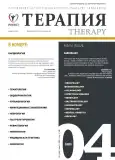Modern opportunities for treatment of patient having chronic heart failure with low ejection fraction
- Authors: Roitberg G.E.1,2, Ardashev A.V.3, Zhelyakov E.G.1, Kondratova N.V.1,2, Merzyavko L.K.1, Ponkina N.K.2, Slastnikova I.D.2, Sokolov D.V.1
-
Affiliations:
- JSC «Meditsina» (Clinic of Academician Roitberg)
- N.I. Pirogov Russian National Research University of the Ministry of Healthcare of Russia
- M.V. Lomonosov Moscow State University
- Issue: Vol 9, No 4 (2023)
- Pages: 103-111
- Section: CLINICAL CASE
- URL: https://bakhtiniada.ru/2412-4036/article/view/274015
- DOI: https://doi.org/10.18565/therapy.2023.4.103–111
- ID: 274015
Cite item
Abstract
Worldwide, the prevalence of chronic heart failure (CHF) is increasing every year, representing a serious medical and social problem. Medicinal drugs can help manage the symptoms of CHF and improve the prognosis in patients, but often the use of drug therapy alone may not be enough. Modern approaches to the treatment of CHF with low ejection fraction (CHFnEF), in addition to drug therapy, also include the use of various electrophysiological methods: implantation of cardioresynchronizing devices, cardioverter defibrillators, interventional treatment of arrhythmias. Article presents an analysis of a clinical case of successful treatment of a comorbid patient with severe CHFrEF using optimal drug therapy, as well as such interventional cardiac surgical interventions as implantation of a cardioresynchronization device with defibrillator function and radiofrequency ablation of arrhythmogenic heart zones.
Full Text
##article.viewOnOriginalSite##About the authors
Grigory E. Roitberg
JSC «Meditsina» (Clinic of Academician Roitberg); N.I. Pirogov Russian National Research University of the Ministry of Healthcare of Russia
Author for correspondence.
Email: contact@medicina.com
ORCID iD: 0000-0003-0514-9114
MD, professor, academician of RAS, head of the Department of therapy, general medical practice and nuclear medicine of the Faculty of additional professional education; head
Russian Federation, Moscow; MoscowAndrey V. Ardashev
M.V. Lomonosov Moscow State University
Email: ardashev@yahoo.com
ORCID iD: 0000-0003-1908-9802
MD, professor, Medical Scientific and Educational Center
Russian Federation, MoscowEvgeniy G. Zhelyakov
JSC «Meditsina» (Clinic of Academician Roitberg)
Email: zheleu@rambler.ru
ORCID iD: 0000-0003-1865-8102
PhD in Medical Sciences, associate professor of the Department of cardiovascular surgery of the Faculty of additional professional education
Russian Federation, MoscowNatalya V. Kondratova
JSC «Meditsina» (Clinic of Academician Roitberg); N.I. Pirogov Russian National Research University of the Ministry of Healthcare of Russia
Email: kondratova@medicina.ru
ORCID iD: 0000-0003-2421-0558
MD, professor of RAS, professor of the Department of therapy, general medical practice and nuclear medicine of the Faculty of additional professional education; head of hospital
Russian Federation, Moscow; MoscowLarisa K. Merzyavko
JSC «Meditsina» (Clinic of Academician Roitberg)
Email: larisa.konst@gmail.com
doctor of functional diagnostics
Russian Federation, MoscowNatalya K. Ponkina
N.I. Pirogov Russian National Research University of the Ministry of Healthcare of Russia
Email: bauhaus33@yandex.ru
resident of the Department of therapy, general medical practice and nuclear medicine of the Faculty of additional professional education
Russian Federation, MoscowIrina D. Slastnikova
N.I. Pirogov Russian National Research University of the Ministry of Healthcare of Russia
Email: slastid@mail.ru
ORCID iD: 0000-0002-4076-2849
PhD in Medical Sciences, associate professor of the Department of therapy, general medical practice and nuclear medicine of the Faculty of additional professional education
Russian Federation, MoscowDenis V. Sokolov
JSC «Meditsina» (Clinic of Academician Roitberg)
Email: sokolovdv@medicina.ru
ORCID iD: 0000-0002-5120-4594
PhD in Medical Sciences, cardiologist
Russian Federation, MoscowReferences
- Clinical practice guidelines for chronic heart failure. Rossiyskiy kardiologicheskiy zhurnal = Russian Journal of Cardiology. 2020; 25(11): 311–374 (In Russ.). https://dx.doi.org/10.15829/1560-4071-2020-4083. EDN: LJGGQV.
- Kokorin V.A., Boeva O.I. Treatment of patients with chronic heart failure and reduced left ventricular ejection fraction: Is there a light at the end of the tunnel? Terapiya = Therapy. 2021; 7(5): 103–111 (In Russ.). https://dx.doi.org/10.18565/therapy.2021.5.103-111. EDN: XZMWIT.
- ESC Guidelines on cardiac pacing and cardiac resynchronization therapy. Rossiyskiy kardiologicheskiy zhurnal = Russian Journal of Cardiology. 2022; 27(7): 289–370 (In Russ.). https://dx.doi.org/10.15829/1560-4071-2022-5159. EDN: UTOLNY.
- clinical guidelines for atrial fibrillation and atrial flutter. Rossiyskiy kardiologicheskiy zhurnal = Russian Journal of Cardiology. 2021; 26(7): 190–260 (In Russ.). https://dx.doi.org/10.15829/1560-4071-2021-4594. EDN: FUZAAD.
- Chamberlain A.M., Redfield M.M., Alonso A. et al. Atrial fibrillation and mortality in heart failure: A community study. Circ Heart Fail. 2011; 4(6): 740–46. https://dx.doi.org/10.1161/CIRCHEARTFAILURE.111.962688.
- McMurray J.J.V., Solomon S.D., Inzucchi S.E. et al. Dapagliflozin in patients with heart failure and reduced ejection fraction. N Engl J Med. 2019; 381(21): 1995–2008. https://dx.doi.org/10.1056/NEJMoa1911303.
- Maddox T.M., Januzzi J.L., Allen L.A. et al. 2021 update to the 2017 ACC expert consensus decision pathway for optimization of heart failure treatment: Answers to 10 pivotal issues about heart failure with reduced ejection fraction: A report of the American College of Cardiology Solution Set Oversight Committee. J Am Coll Cardiol. 2021; 77(6): 772–810. https://dx.doi.org/10.1016/j.jacc.2020.11.022.
- Bokeria L.A., Neminushchiy N.M., Postol A.S. Cardiac resynchronization therapy. Indications and novel approaches to the improvement of its efficiency. Kompleksnyye problemy serdechno-sosudistykh zabolevaniy = Complex Issues of Cardiovascular Diseases. 2018; 7(3): 102–116 (In Russ.). https://dx.doi.org/10.17802/2306-1278-2018-7-3-102-116. EDN: VBHZZK.
- Shlyakhto E.V., Arutyunov G.P., Belenkov Yu.N., Ardashev A.V. Sudden cardiac death. Moscow: Medpraktika-M. 2015; 704 pp. (In Russ.). ISBN: 978-5-98803-349-3.
- Proietti R., Sagone A. Electrical storm: Incidence, prognosis and therapy. Indian Pacing Electrophysiol J. 2011; 11(2): 34–42.
- Postol A.S., Vygovsky A.B., Neminuschy N.M. ICD therapy at the present stage: opportunities to reduce inadequate shocks. Meditsinskiy al’manakh = Medical Almanac. 2018; (1): 88–95 (In Russ.). EDN: YWNRKZ.
- Talibullin I.V., Lebedeva N.B. Implantable cardioverter-defibrillators in the prevention of sudden cardiac death: current recommendations for use and real clinical practice (literature review). Byulleten’ sibirskoy meditsiny = Bulletin of Siberian Medicine. 2022; 21(1): 183–196 (In Russ.). https://dx.doi.org/10.20538/1682-0363-2022-1-183-196. EDN: CSKUZE.
- Ardashev A.V. Clinical arrhythmology. Vol. 3. Moscow: Medpraktika-M. 2021; 429 pp (In Russ.). ISBN: 978-5-98803-449-0.
- Blanck Z., Akhtar M. Ventricular tachycardia due to sustained bundle branch reentry: Diagnostic and therapeutic considerations. Clin Cardiol. 1993; 16(8): 619–22. https://dx.doi.org/10.1002/clc.4960160812.
Supplementary files















